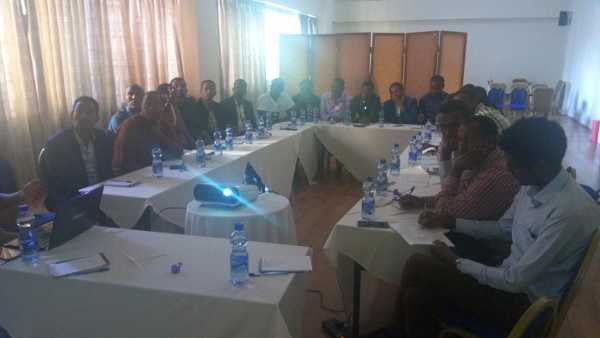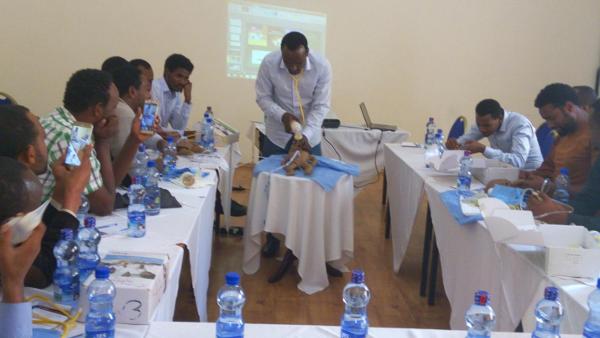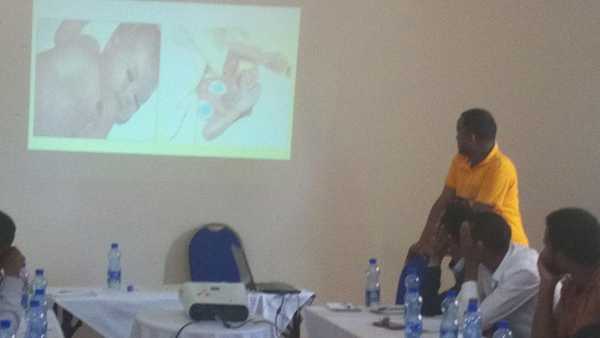Neonatal Resuscitation Training Report - October 2017
Trainer/facilitator
Fitsum Taye (Bsc in Public health officer, Msc in emergency surgery)
Felegemeles HC, Addis Ababa
[email protected]
+251905596018
Melese Takele (Bsc in Public health officer, Msc in emergency surgery)
Felegemeles HC, Addis Ababa
[email protected]\
+251913725145
www.paesoe.org
Organized by PAESOE in collaboration with UNFPA
Report organized by: Melese Takele, Nevember 2017, Addis Ababa
Abbreviations
CME - Continuous Medical Education
ESO - emergency surgical officer
PPH - Post Partum Hemorrhage
UNFPA - United Nations fund for population activities
Acknowledgements
We wish to express our sincere gratitude to UNFPA executives for their financial and moral support that enabled this training to take place. We especially acknowledge the Midwifery Specialist Dorothy Eunice lazaro and National Midwifery Advisor S/r Aster for their unlimited support of sharing ideas and borrowing materials from Ethiopian Midwives Association.
We would also like to thank the health facilities that responded to our call and sent their health workers to be trained.
Contents
- 1.0 Introduction
- 2.0 Activities
- 3.0 Pre-test
- 4.0 Presentations
- 5.0 Demonstration
- 6.0 Post Test
- 7.0 Achievements
- 8.0 Recommendations
- 9.0 Feedback from participants
- 9.1 Lessons learned
- 9.2 Suggested topics for further training
- Annex
- 10. Pre and Post test questions
1.0 Introduction
Different studies were conducted and have agreed the deployment of ESOs in all health facilities (Primary and General Hospitals) has resulted in remarkable increase in volume of MNH and emergency surgical services with improvement in maternal and perinatal outcomes.
Most of ESOs are working in rural hospital where there are limited newborn care services and no trained isolated health professionals for new born babies. They are also responsible to help and coach midwives in resuscitating and evaluating the babies. So boosting their capacity on neonatal resuscitation and newborn evaluation is the paramount important.
Understanding this, professional association for emergency surgical officers of Ethiopia in collaboration with UNFPA took the initiative to conduct two days refreshment training for 25 IESOs, held on 28^th^ and 29^th^ of October, 2017 in Embilta Hotel, Addis Ababa.
The aim of the training was to equip ESOs with advanced neonatal resuscitation skills using basic equipment and to enhance their knowledge on newborn evaluation before referral to the best set up.
The learning objectives of the participants were that;
- Demonstrate an understanding of the physiology asphyxia
- Assess the new born at birth
- Perform resuscitation of new born using basic equipment
2.0 Activities
Activities included;
- Pre-test
- Oral Presentations
- Illustration
- Return Demonstration
- Post test
- Feedback from the participants
3.0 Pre-test
The pre – test included basic questions on initial assessment of the new born, immediate care of the new born and resuscitation techniques. The highest score was 91% while the lowest scored 68% with an average score of 80%.
4.0 Presentations
The first presentation covered; an overview on neonatal deaths, neonatal asphyxia, and risk factors of neonatal asphyxia, initial assessment at birth and airway management.
The second presentation covered the equipment used in neonatal resuscitation and steps of neonatal resuscitation, and new born evaluation.


5.0 Demonstration
The participants were divided into four groups and allocated different resuscitation stations. The facilitator demonstrated the steps of neonatal resuscitation and there was a return demonstration from each of the participants

Participants during the practical session
6.0 Post Test
The same test was done to compare the performance of the participants before and after the training. For the post-test a highest score of 97% and lowest 76% with an average of 86.5% were obtained. Health workers were asked which neonatal resuscitation equipment they had and among 20 facilities only 13 facilities had 50 % or more of the basic required equipment.
7.0 Achievements
- Bringing all ESOs together enabled us to discuss the strengths and weaknesses of each side.
- We have received positive feedback from the health facilities where the participants came from.
- There was an increase in knowledge of the neonatal resuscitation process at the end of the training as shown in the scores from the post-test.
8.0 Recommendations
- The TOT training should be considered for Emergency surgical officers to conduct institutional based /on job training for all midwives.
- Trainees should disseminate what they have learned to fellow health workers in respective health facilities through CME sessions
- For midwives working in hospitals, such training should be incorporated in their Continuous Medical Education (CME) sessions
- Birth attendants in clinics, in the community need to be attached to health facilities that conduct regular CME sessions.
9.0 Feedback from participants
9.1 Lessons learned
- Proper steps in resuscitation (positioning, when to stop, when to start compressions and suctioning)
- Pathophysiology of asphyxia
- What to do during cardiopulmonary resuscitation
- Making the operating room ready with the resuscitation table
- Preparing the baby for resuscitation (drying, tilting)
- How to use resuscitation equipment (Ambu bag, bulb)
- How to properly evaluate the newborns before referral
- Importance of immediate referral to Hospital if resuscitation fails
- Use of Stethoscope in monitoring heart rate during resuscitation
- Importance of skin to skin contact after birth of a baby
- Resuscitation of mothers, and neonates with asphyxia
- Appearance of a premature baby
- Keeping the baby warm after birth
9.2 Suggested topics for further training
- Advance neonatal resuscitation training or TOT training
- Advanced life support for obstetrics training (ALSO - training)
- Refreshment training on surgical Management/control of Post Partum Haemorrhage (PPH)
- Training on maternal and perinatal death audit
- Refreshment training on obstetrics ultrasound
At the end of the day, participants were given brochures and notes on neonatal resuscitation.
Annex
10. Pre and Post test questions
NEONATAL RESUSCITATION TRAINING PRE – TEST and post test
Instruction: Circle the most appropriate answer
1. If During delivery of an infant you notice that the amniotic fluid is greenish in colour, contains thick particles of Meconium, poor muscle tone and poor respiratory effort. Which of the following is the most important initial step?
A. Dry the baby and stimulate the baby B. Determine the APGAR score C. Initiate Intubation D. Suction
2. At birth, an infant has the following findings; poor and irregular respiratory effort, blue all over the body, no reflex irritability, no movement of the limbs, and heart rate of 70beats per minute. What is the APGAR score?
A. 4 B. 5 C. 2 D. 1
3.All of the following may be required in a one hour old neonate with severe birth asphyxia except;
A. BCG vaccine B. Oxygen C. Normal saline D. Sodium Bicarbonate
4.When are chest compressions initiated in neonatal resuscitation?
A. When the heart rate is below 100 beats per minute B. When the heart rate is below 60 beats per minute
C. When the heart rate is below 120 beats per minute D. When the heart rate is below 40 beats per minute
5.What ratio of chest compressions and breaths are given during a cardiopulmonary resuscitation?
A. Three compressions for every one breath B. Two compressions for every one breath
C. One Compression for every 15 breaths D. Three compressions for every 15 breaths
6.A midwife has been performing a cardiopulmonary resuscitation for about 90 seconds, the neonate has maintained a heart rate of 40 beats per minute. What should be recommended at this point of time?
A. Continue resuscitating B. Give more inflation breaths
C. Administer epinephrine D. Suction
7.Which of the following actions constitutes appropriate stimulation of a neonate?
A. Gently slapping the infants buttocks B. Gently shaking the infant
C. Blowing the infant D. Drying the infant and Flicking the infants feet
8.What measures can the Midwife take to prevent heat loss during resuscitation?
1 Dry the infant 2. Remove wet linens and wrap in dry linen
3 Resuscitate on a warmer 4. Measure body temperature
A. 1, 2 and 3 B. 1, 2 and 4 C. 1 only D. 4 only
9.A neonate has a heart rate of 50 beats per minute what should the mid wife do?
A. Administer medication B. Start chest compressions
C. Give inflation breaths only D. Do nothing as this neonate cannot be resuscitated
10.The following factors may predispose a neonate to asphyxia except
A. Prolonged labour B. Small for age Neonate C. Multiple pregnancy D. Ante partum bleeding
PART II
a) Name the basic equipment for resuscitation
I
II
III
b) How can you assess whether resuscitation is successful
c) When should one stop resuscitation